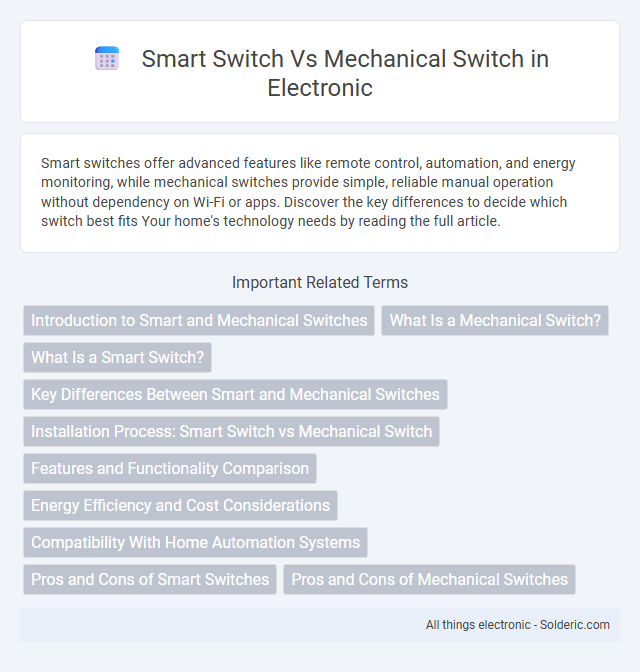Smart switches offer advanced features like remote control, automation, and energy monitoring, while mechanical switches provide simple, reliable manual operation without dependency on Wi-Fi or apps. Discover the key differences to decide which switch best fits Your home's technology needs by reading the full article.
Comparison Table
| Feature | Smart Switch | Mechanical Switch |
|---|---|---|
| Control Method | Wireless via app, voice, or automation | Manual physical toggle |
| Connectivity | Wi-Fi, Zigbee, Z-Wave, Bluetooth | No connectivity |
| Installation | Requires compatible wiring and hub (optional) | Simple plug-and-play |
| Features | Scheduling, remote access, energy monitoring | Basic ON/OFF functionality |
| Power Consumption | Low standby power usage | No standby power |
| Cost | Higher initial investment | Low cost |
| Compatibility | Works with smart home ecosystems | Compatible with all standard fixtures |
| Security | Requires regular updates and secure network | No cybersecurity risks |
Introduction to Smart and Mechanical Switches
Smart switches integrate advanced technology to control lighting systems remotely via apps or voice commands, offering convenience and energy efficiency. Mechanical switches rely on physical toggles or buttons to complete electrical circuits manually, providing simple and reliable on/off functionality. Understanding these differences helps optimize Your home automation and traditional lighting setup.
What Is a Mechanical Switch?
A mechanical switch is a physical device that controls the flow of electricity by manually opening or closing an electrical circuit, typically using a lever or button. It relies on mechanical components like springs and contacts to establish or break connections, providing tactile feedback and reliable operation. Unlike smart switches, mechanical switches do not offer remote control or automation features, making them simple but limited in functionality.
What Is a Smart Switch?
A smart switch is an advanced electrical device that allows users to control lighting and appliances remotely via Wi-Fi or a mobile app, offering programmable schedules and integration with home automation systems like Alexa or Google Assistant. Unlike mechanical switches, which operate through physical toggling, smart switches use electronic components to enable features such as voice control, energy monitoring, and automation. These switches enhance convenience, improve energy efficiency, and support smart home connectivity through seamless wireless communication.
Key Differences Between Smart and Mechanical Switches
Smart switches offer remote control, automation, and integration with home systems through Wi-Fi or Bluetooth, unlike mechanical switches that provide simple on/off functionality with physical toggles. Mechanical switches excel in tactile feedback and reliability without dependence on internet connectivity or power, making them ideal for straightforward manual operation. Your choice depends on whether you prioritize advanced technology features or classic, durable simplicity in your electrical controls.
Installation Process: Smart Switch vs Mechanical Switch
The installation process for a smart switch typically involves connecting the device to your home Wi-Fi network and integrating it with a compatible app, which may require a neutral wire and some familiarity with electrical wiring. Installing a mechanical switch is generally straightforward, involving basic wiring to replace an existing switch without network setup. Your choice depends on your comfort level with technology and whether you want enhanced control features or simple functionality.
Features and Functionality Comparison
Smart switches offer remote control, scheduling, and integration with home automation systems, enhancing convenience and energy efficiency. Mechanical switches provide reliable, manual on/off control without the need for power or connectivity, ensuring simplicity and durability. Your choice depends on whether you prioritize advanced features like app control and voice activation or straightforward, tactile operation.
Energy Efficiency and Cost Considerations
Smart switches enhance energy efficiency by allowing remote control and automation, reducing unnecessary power consumption through scheduled on/off settings and real-time monitoring. Mechanical switches, while low-cost and simple, lack these energy-saving features, potentially leading to higher electricity usage. Although smart switches have a higher upfront cost, their energy-saving benefits can result in long-term cost reductions on utility bills.
Compatibility With Home Automation Systems
Smart switches offer seamless compatibility with popular home automation systems such as Google Home, Amazon Alexa, and Apple HomeKit, enabling remote control and voice commands. Mechanical switches operate independently without integration capabilities, limiting automation and remote access. Choosing a smart switch enhances Your home's connectivity and convenience by synchronizing lighting with other smart devices.
Pros and Cons of Smart Switches
Smart switches offer remote control, automation, and energy monitoring which improve convenience and efficiency in your home. They require a stable Wi-Fi connection and may have higher upfront costs compared to mechanical switches. While smart switches enhance functionality and integration with home automation systems, mechanical switches excel in simplicity, reliability, and affordability without dependence on connectivity.
Pros and Cons of Mechanical Switches
Mechanical switches offer tactile feedback and durability, making them ideal for users who prioritize precise control and long-lasting performance. They typically require more force to actuate, which can result in faster typing accuracy but may cause finger fatigue during prolonged use. Your choice depends on whether you value the robust, responsive feel of mechanical switches over the quieter, less resistant smart switch alternatives.
Smart switch vs Mechanical switch Infographic

 solderic.com
solderic.com